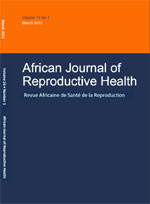
|
African Journal of Reproductive Health
Women's Health and Action Research Centre
ISSN: 1118-4841
Vol. 22, No. 2, 2018, pp. 9-16
|
 Bioline Code: rh18018
Bioline Code: rh18018
Full paper language: English
Document type: Comment
Document available free of charge
|
|
|
African Journal of Reproductive Health, Vol. 22, No. 2, 2018, pp. 9-16
| fr |
Gurusamy, Pari Shanmuga Raman & Janagaraj, Priya Darshene
Résumé
Partout dans le monde, le fardeau de la mortalité maternelle, néonatale et infantile est partagé de manière disproportionnée entre les pays les moins avancés et les pays développés. Alors que la mortalité maternelle mondiale a presque diminué de moitié depuis 1990, 99% des décès maternels dans les régions en développement sont 14 fois plus élevés que dans les régions développées. L'Organisation des Nations Unies (ONU) a établi huit objectifs du Millénaire pour le développement (OMD), notamment l'amélioration de la santé maternelle (OMD 5) et la réduction de la mortalité infantile (OMD 4). Le Rwanda est l'un des rares pays à avoir atteint les OMD 4 et 5 à l'avance. En 2015, l'ONU a établi 17 Objectifs de Développement Durable (ODD), une version renouvelée des objectifs à atteindre d'ici 2030, y compris la santé et le bien-être (ODD 3). L'ODD 3 vise à atteindre un taux de mortalité maternelle (TMM) global de 70 ou moins d'ici 2030, ce qui nécessite une réduction annuelle du TMM de 7,5%. Le Rwanda est sur la bonne voie pour atteindre ses cibles d'ODD avec le soutien du gouvernement local, des donateurs et des agences internationales et locales. L'approche multiforme mise en place par le gouvernement rwandais, soutenue par des organisations internationales, est à mettre au crédit de ce succès. L'étude de ces stratégies et interventions éprouvées nous permettra d'identifier les lacunes, de les développer et éventuellement de les transférer dans le reste du monde, avec une remise en contexte appropriée. (Afr J Reprod Health 2018; 22[2]: 9-16).
Mots Clés
Afrique subsaharienne; Rwanda; mortalité maternelle; mortalité infantile; mortalité néonatale
|
| |
| en |
A Success Story: The Burden of Maternal, Neonatal and Childhood Mortality in Rwanda - Critical Appraisal of Interventions and Recommendations for the Future
Gurusamy, Pari Shanmuga Raman & Janagaraj, Priya Darshene
Abstract
Globally, the burden of maternal, neonatal and childhood mortality is disproportionately shared between the least developed nations and the developed nations. While the global maternal mortality has been almost halved since 1990, 99% of maternal deaths occur in developing regions. This invariably highlights the impact of poverty and, to combat poverty in its different elements, the United Nations (UN) established eight Millennium Development Goals (MDGs), including improving maternal health (MDG 5) and reducing child mortality (MDG 4). Rwanda is one of the few countries that have met both MDGs 4 and 5 ahead of time. In 2015, the UN established 17 Sustainable Development Goals (SDGs), a renewed version of targets to be achieved by 2030, including Good Health and Well-being (SDG 3). SDG 3 aims to achieve a global maternal mortality rate (MMR) of 70 or less by 2030, requiring an annual reduction in MMR by 7.5%. Rwanda is on track to achieving its SDG targets with the support of local government, donors, and international and local agencies. The multipronged approach initiated by the Rwandan government, backed by international organizations, is to be credited for this success. Studying these proven strategies and interventions will allow us to identify gaps, further develop and eventually transfer them to the rest of the world, with suitable contextualization. (Afr J Reprod Health 2018; 22[2]: 9-16).
Keywords
Sub-Saharan Africa; Rwanda; Maternal Mortality; Childhood Mortality; Neonatal Mortality
|
| |
© Copyright 2018 - African Journal of Reproductive Health
Alternative site location: http://www.ajrh.info
|
|
